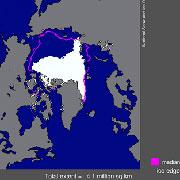 16 Sept 2007: the long-term average summer sea ice extent is shown by the pink line, today’s ice extent is shown in white.National Snow and Ice Data Center
16 Sept 2007: the long-term average summer sea ice extent is shown by the pink line, today’s ice extent is shown in white.National Snow and Ice Data CenterEven for a society jaded by the continual breaking of climate records, the retreat of Arctic ice this year is stunning.
Sea-ice extent — the total number of 25 x 25 kilometer square sections of ocean covered by at least 15% ice — in the Arctic Ocean melts from about 16 million km2 every March to a minimum sometime in September or October, the exact date normally only being evident in retrospect. The US National Snow and Ice Data Center (NSIDC) says the previous record absolute minimum was 5.32 million km2, set in 2005. This year has already reached 4.14 million km2 — the lowest since records began in the late 1970s.
This has opened the Northwest Passage — the most direct shipping route between the Atlantic and Pacific Oceans, from Russia along the north coast of Canada to Europe. It is now navigable without an icebreaker.
"I'm shocked daily, looking at the maps," said Marika Holland, sea-ice researcher at the US National Center for Atmospheric Research in Boulder, Colorado, earlier this month. "Where it's going to bottom out, I wouldn't hazard a guess."
“I'm shocked daily, looking at the maps.”
Marika Holland
Some models suggest that if the current trends continue, we'll hit a first summer day entirely free of sea ice sometime between 2050 and 2100 1,2 - dates accepted by the Intergovernmental Panel on Climate Change. Other studies predict it could happen even earlier3.
"The observations and the climate models both point in the same direction, and that direction is we will reach a seasonal ice-free state. I wouldn't say it's inevitable; without some important changes I think that it's likely," says Holland. She adds: "In general, the models seem to be conservative compared to the observations."
Going, going, gone
As well as examining the area over which sea ice is prominent, scientists also look at the actual area of ice. Processing of NSIDC data by researchers at the University of Illinois, Urbana-Champaign, puts the previous 2005 record for area at 4.01 million km2, with this year's sea-ice area currently at 2.92 million km2.
There are three ideas as to what could have caused such a dramatic drop this year, according to John Walsh, of the University of Illinois's Department of Atmospheric Sciences. Ocean waters have been warmer in the past few summers, which would have encouraged melting. This summer has also been "unusually cloud free", again encouraging melting. Finally, he says, spring temperatures over the Russian section of the arctic were also higher than usual.
Feedback effects may make recovery from this new low harder — ice reflects sunlight whereas open sea absorbs it. So less ice this year will militate against lots of ice next year, as well as boosting global warming.
"This year does stand out as a jump downward," says Walsh. "I would say the odds favour an extreme year next year too."
Thin ice
Whether global warming should be blamed entirely for this year's low is not entirely clear. Variation in the factors mentioned by Walsh is not necessarily caused by climate change. But a warmer planet has resulted in thinner ice, which is more vulnerable to warm weather.
ADVERTISEMENT
Initial results from a German survey that were revealed last week show that arctic ice is approximately 50% of its 2001 thickness.
As if to drive home how complex the sea-ice problem is, as the Northern Hemisphere hits record lows, at the other side of the world the sea-ice area is close to breaking the record for maximum area of 16.03 million km2.
As well as opening up trade routes, the reduction of sea ice in the north will have consequences on local wildlife too. The most visible example of this will be polar bear populations; newly released reports from the US Geological Survey (USGS) suggest that two-thirds of the bears could be lost within 50 years because of reduced sea ice. Polar bears rely on the ice as a hunting platform and the USGS models predict a 42% loss of habit in the key summer breeding months.
Visit our seaiceatrecord_low.html">newsblog to read and post comments about this story.
